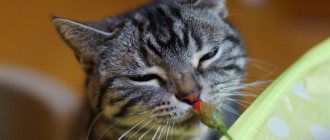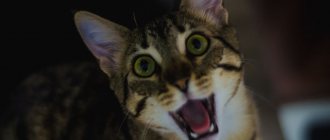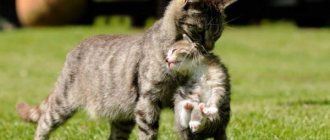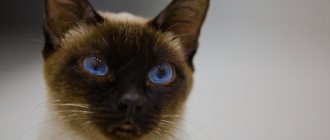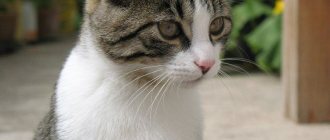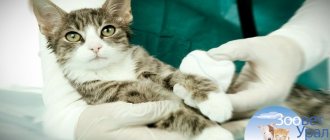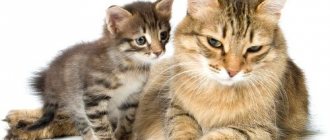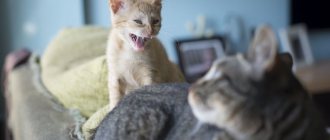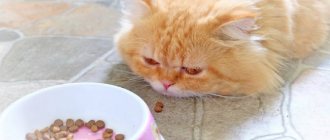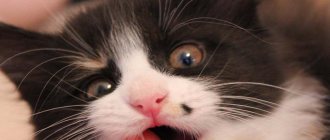Coughing in a cat is a fairly common occurrence, indicating irritation of the center in the brain. There may be several reasons why a pet may cough, as if it is choking. It is unacceptable to leave such a symptom unattended, since the provoking factor can be both a cold infection and serious forms of bronchial asthma.
By carefully observing the animal and changes in health and condition, the owner can independently determine some of the reasons that provoked the cough.
By its nature, cough is not a disease. This is a kind of signal from the body, a specific reflex that occurs in the body when certain parts of the respiratory tract are irritated.
The cause may be household dust, chemicals (various acid-containing substances and alkalis), pathogenic bacterial microorganisms, viruses and fungal spores. Due to the appearance of a cough, the body tries to independently eliminate the irritating factor - mucus, exudate arising from inflammatory processes, foreign bodies.
It is necessary to understand what can trigger a cough in a cat in order to promptly contact a veterinarian for advice and detailed diagnosis. Only in a veterinary clinic will a cat be given adequate treatment.
A cat sneezes - why is it dangerous?
- Sneezing is a beneficial function of the body in which it forcefully expels irritants from the nose.
- However, if your cat's sneezing does not go away, or if other symptoms occur along with the sneezing, you may need to consult your veterinarian to find out how dangerous it is.
Because viral, bacterial or fungal infections of the upper respiratory tract, which are characterized by symptoms such as constant sneezing, nose, eyes, etc., are contagious to people.
Free consultation Moscow
+7(495)162-70-70
Helminthiasis
Extensive parasite infestation may explain why the cat grunts. Some types of worms develop in the lungs. By feeding on blood, tissues and multiplying in the respiratory tract, helminths provoke the occurrence of an inflammatory process and the formation of pathogenic microflora. As a result, the cat develops breathing problems accompanied by grunting.
In advanced stages, grunting and coughing result in vomiting, in which live parasites can be found. Treatment of pets with anthelmintic drugs should be carried out not only for therapeutic, but also for preventive purposes.
Symptoms of Cat Sneezing
- Sudden attacks of sneezing
- Watery or purulent nasal discharge
- Loss of smell
- Discharge from the eyes
- Inflammation of the conjunctiva of the eye (conjunctivitis)
- Mouth ulcers
- Lack of appetite
- Arthritis
- Heat
- Pneumonia
- General malaise
- Feline herpes virus (feline viral rhinotracheitis)
- Treatment is aimed at controlling symptoms.
- Broad-spectrum antibiotics.
- Ophthalmic antiviral drugs.
- Decongestant drops.
- Good food.
The best way to prevent this type of infection is to vaccinate your cat against feline herpes.
Feline calicivirus.
- There are no special medications for viral infections of this type. To prevent or treat secondary bacterial infections, which are usually observed with viral infections, use:
- broad spectrum antibiotics
- ophthalmic antibiotics
- painkillers prescribed by a veterinarian
- inserting feeding tubes until the mouth ulcers heal.
- The cat requires careful care for the entire period of recovery from calicivirus infection:
- Clearing your cat's eyes and nose of accumulated secretions
- medication use
- preparing special food
- fluid therapy (quick restoration of the body’s water and electrolyte balance)
The best way to prevent this type of infection is to vaccinate your cat against calicivirus.
Bacterial infections
- Bordetellosis
- A contagious bacterial disease of cats that primarily causes abnormalities of the upper respiratory tract. For cats with uncomplicated infections:
- antimicrobials
- fluid therapy
The best way to prevent this type of infection is to vaccinate your cat against Bordetella.
Mycoplasmosis
- This is the general medical name for a disease that is caused by bacterial parasitic microorganisms that live without oxygen and are capable of self-production.
- Depending on the severity and location of the condition, antibiotics may be prescribed to treat the infection.
Allergy
- Atopic (respiratory) allergies occur in cats with weakened immune systems. And the reasons for this may be:
- cat litter
- cigarette smoke
- pest sprays
- cleaners
- air freshener
- dust
- pollen
- In addition to sneezing, allergies in cats are characterized by ulceration of the skin. Treatment can be episodic (during an exacerbation): sprays, antihistamines.
Foreign body
- The presence of a foreign body is diagnosed using rhinoscopy, in which a camera is inserted into the cat's nose. Or by using a nasal irrigation, in which a sterile saline solution is passed through the nasal passages (under anesthesia) to remove material that the cat could not expel by sneezing.
Dental disease
- The roots of the teeth of the upper jaw are located next to the nasal passages. When teeth decay, the barrier between the socket of the teeth and the nose can be damaged. Therefore, when a cat eats, food can enter the nose, triggering a sneeze reflex.
- Treatment of dental disease by removing the affected tooth or closing the abnormal hole.
Neoplasia (tumors)
- Tumors are always on the list of possible causes, especially in older cats. Tumors can grow inside the nasal passage, creating irritation and inflammation that causes the cat to sneeze. These tumors are usually detected visually using rhinoscopy or nasal biopsy.
- The prognosis is pretty bad.
Fungal infection
- Although fungal infections are less common than viral or bacterial infections, they are also a cause of sneezing in cats.
- Cryptococcosis is a painful condition that is a localized or systemic fungal infection caused by Cryptococcus neoformans. Cryptococcus fungus is contracted through the nasal passages, from where it travels to the brain, eyes, lungs and other tissues. Lung infection and central nervous system dysfunction leading to meningitis are the most common causes of death from cryptococcosis. Treatment is long lasting for several months.
Paroxysmal breathing
Every owner has at least once witnessed a situation where a cat grunts, sneezes and tries to breathe in air at the same time. At the same time, her eyes are wide open, she arches her back and presses her front paws to her chest. Veterinarians describe this condition as paroxysmal breathing. For the most part, it does not pose any threat, but you should be wary if :
- the frequency of attacks increases over a short period of time;
- a secondary symptom is vomiting, especially with blood;
- The cat began to sleep restlessly and seemed to be suffocating in his sleep.
Not only cats, but also dogs suffer from this. Attacks can be considered rare if they occur no more than 1-2 times a month. If the problem begins to bother you every day, you need to consult a doctor as soon as possible.
© shutterstock
Why is mucus formed?
The production of mucous masses by the nasopharynx is a natural phenomenon. They perform a moisturizing and protective function. Mucous masses trap foreign particles, pollen, and bacteria that enter with the air and prevent them from descending lower into the trachea and lungs. As soon as these foreign agents enter the mucous membranes, the amount of secretion produced increases, and the person has a desire to clear his nose or cough. When the irritant is removed from the body, secretion production returns to its previous level.
Normally, a person does not notice the process of formation of mucous masses - they are swallowed along with saliva.
The accumulation of mucus in the throat becomes noticeable when it is produced continuously and thickens. The patient directly feels how mucous masses flow along the back wall of the pharynx and accumulate in it. During the daytime, the accumulation of sputum is not so disturbing - it is swallowed and does not greatly irritate the cough receptors. But if you take a horizontal position, for example, at night while sleeping, the mucous masses cannot freely pass inside and stagnate in the throat. This causes severe coughing attacks, which can even provoke vomiting.
When a person comes to an otolaryngologist and says: “I constantly swallow mucus in my throat,” the first thing the ENT doctor will do is find out why mucus accumulates in the throat.
Only after establishing the true cause of mucus in the throat, it will be possible to prescribe the correct treatment.
Signs and types of wheezing
When observing how a pet coughs, one involuntarily draws an analogy with a human cough. But unlike a person, when coughing they stand in a certain position, stretching their neck forward as much as possible, making sounds reminiscent of an attack of vomiting.
By its nature, the cough mechanism is carried out as a result of strong irritation of the receptors of the mucous membrane lining the respiratory tract (nasal passages, bronchial tree or the lungs themselves).
Quite often, the cause of a severe cough in a cat is inflammatory processes occurring in the respiratory tract. As a result of a developed pathological process, a large accumulation of a specific secretion – mucus – occurs in the lumen of the larynx.
The body is trying to get rid of the irritating factor. A signal is transmitted to a certain center of the brain, transmitted along nerve endings, provoking irritation of the cough center. From this center impulses go to the larynx. Against the background of this process, the muscle fibers located in the larynx under the influence of the reflex contract.
When exhaling, the glottis is open, which is why a specific sound called a cough occurs. The owner’s task is to promptly detect such a sound being made and the posture being taken. This will make it possible to promptly contact a specialist for help, preventing the development of possible complications.
It is necessary to know what types of cough exist in veterinary medicine, their characteristic features and the consequences they have for the normal condition of the pet.
Veterinarians divide cough in domestic cats into several types. The cough can be acute or chronic.
The acute form of cough is characterized by a sudden appearance of the reflex, and the duration ranges from several days to 1 week.
A chronic type of cough can last from several weeks to several months.
Coughs are also classified according to their sound - muffled and loud, and according to the nature of the accompanying discharge - dry or wet.
In turn, the dry type of cough has its own symptoms. The cat wheezes, and the cough that escapes is abrupt and loud.
The wet type of cough is characterized by the appearance of peculiar gurgling sounds, accompanied by the release of mucous secretions, sputum, or even blood.
The time of day when a dry or wet cough appears is completely unimportant.
With a weak cough, the animal does not particularly strain. But for a strong one, the following clinical picture is typical - the cat coughs and wheezes, stretching out and snuggling, as if she had nausea and vomiting.
The pet owner should note any peculiarities when the cat coughs, which will allow the veterinarian to create a more accurate picture of what is happening when collecting an anamnesis and determine the exact factor that provoked the pathology. In addition, a detailed medical history makes it possible to choose the correct and most effective treatment tactics.
If there is not only a cough, but also a stuffy nose in a cat, this type of pathological process is called respiratory. Body temperature may increase, and the general condition is depressed.
A set of symptoms along with a cough may indicate the onset of an inflammatory process in the lungs or bronchial tree. Characteristic symptoms do not appear immediately, but after a certain period of time. With increasing symptoms, the cough will be loud and dry, without secretions of specific secretions, sputum and blood.
Another type of cough is also defined in veterinary medicine – cardiac. The cardiac type of cough develops due to pathological processes occurring in the myocardium. This cough is not accompanied by the production of sputum and mucus.
The main cause of cardiac cough is severe thickening of the myocardial walls or the accumulation of pathological exudate in the pulmonary structures, provoked by disturbances in the circulatory system. With a cardiac cough, the following symptoms are observed - the cat is breathing heavily, as if she does not have enough air. Instead of nasal breathing, inhalation through the mouth is noted.
A cough can occur as a result of irritation of the mucous membranes by foreign protein components - an allergic reaction. With a weak reaction, the pet may simply cough from time to time, and there may be discharge from the nose.
Severe allergies can cause coughing to such an extent that the animal begins to choke. In such cases, it is necessary to urgently contact a 24-hour veterinary clinic for immediate help.
Pet treatment
If, upon examination, the doctor does not identify any acute reason why the kitten is sneezing, then he may prescribe wet cleaning for preventive purposes and recommend purchasing a humidifier.
Any diseases of the respiratory tract will require the use of nasal agents to relieve swelling of the nasal mucosa. More serious complications are treated with antibiotics. After healing, the sneezing will go away on its own.
Polyps or other neoplasms are removed surgically if the veterinary clinic has special equipment and a properly qualified specialist. Otherwise, the pet may be sent to another clinic equipped with everything necessary.
Murkoshi specialists do not recommend trying to remove foreign objects in a cat’s nose at home: if you do not have the appropriate experience (and you probably don’t), you will only push the object even deeper and aggravate the cat’s already difficult condition. Instead, take your purr to the veterinary clinic. There, the specialist will remove the foreign body and recommend further treatment to relieve inflammation.
Read more: How to choose the right veterinary clinic for a cat?
If you have an allergy, you will need to take a test to identify the allergen. To relieve side effects (itching, swelling, sneezing, coughing), the veterinarian will prescribe antihistamines, antipruritics, diuretics, and, if necessary, antishock agents.
For infections, a specialist prescribes antibiotics, antiviral drugs and probiotics.
Read about infections: What are the types of infections in cats and how to treat them
Diagnosis of the condition
To diagnose coughing and wheezing in a cat, a medical history is taken. This is an important part of the diagnosis procedure. The specialist must have a clear picture of what is happening (feeding rules, diet, living conditions, the onset of pathology). After collecting anamnesis, a number of special laboratory and instrumental studies are prescribed. The main ones are:
- physical examination of visible respiratory tracts;
- listening to the bronchial tree, trachea and lungs using a phonendoscope;
- general clinical blood test and blood biochemistry (if necessary);
- coprogram (carried out to exclude the presence of helminths in the body).
Specific tests for the presence of bacteria and viruses are carried out if the presence of a pathogen circulating in the blood is suspected. Instrumental diagnostics include ultrasound examination of the heart if myocardial disease is suspected.
An X-ray examination is also carried out to visualize the cat’s internal organs and possible changes in their size and location. In some cases, it is necessary to carry out washouts from the trachea.


